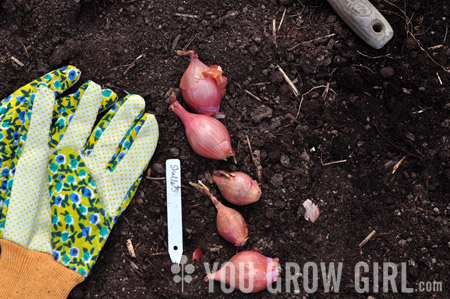
The other day I wrote about hardening off onion and leek seedlings. This week I am planting out onion and shallot “sets”. Planting sets may seem redundant since I already have seedlings on the go, but I assure you there is a method to this madness.
In my house, we cook with shallots and onions everyday and we never seem to have enough. This year I plan to step up my game and grow more than ever. I don’t want them to be ready for harvest at the same time. Now THAT would be madness. Starting from a range of sources (seed, sets, and even store-bought transplants) allows me to have a steady stream of edible alliums (as well as tender onion greens) available for use in our meals throughout the growing season and well beyond. Not only have I already been using the fresh greens clipped from my onion seedlings, but I have even harvested some of the full-sized perennial bunching onions that I planted last fall! Over the years I have found that if I take care to plant at intervals and protect the plants, I can have some form of edible allium available almost year-round!
What are “Sets”?
Sets are immature bulbs that were started from seed the previous year. The seed are sown closely so that they stay small and then pulled when they are about a half an inch round. Shallots grow in clusters by multiplying from the original bulb, sort of like garlic. For that reason shallot sets are simply individual, full-sized (or very nearly) bulbs.
The Pros and Cons of Growing Sets
- Pros
- Sets are already partway through their growth cycle so they are well ahead of their seed-grown counterparts, resulting in an earlier harvest.
- Sets are less work.
- They’re a good option if you have trouble growing from seed or simply lack the space to do it. [Note that you can direct sow bunching onion seed outside, too.]
- Sets are super easy to plant and fun, educational work for kids.
- Cons
- Sets are weaker than seed grown plants.
- Sets don’t tend to store as well.
- Sets tend to be more susceptible to insect damage and disease.
- Sets are more prone to bolting in the heat than seed grown plants.
- Only a few varieties tend to be available as sets, reducing the range of varieties that you can grow.
- They’re a little more expensive than growing from seed.

How I Plant Onion and Shallot Sets
Where to Grow: Full sun is best. You can grow in shadier spots, but beware that bulbing onions will not reach their potential in the shade. For that reason I tend to place only scallions, aka bunching onions, in shadier spots.
Bulbing onions do best in rich soil that drains well, but has a lot of organic matter. I grow mine in raised beds and add lots of compost before planting. Again, bunching onions will grow (albeit smaller and more slowly) in less than primo soil, so you can always reserve the best space for the biggest varieties and stick the scallions wherever you have space.
You’ll notice in the photo that I added a little bit of dried kelp meal to the planting hole.
How to Plant:
Plan to plan sets soon after the soil is thawed and soft enough to work. In my region that’s about early to mid-April, depending on the weather that year.
Sets should be planted so that the bulb tops are level with the soil surface and the little tips are just poking out.
I plant bulbing onion sets about 3″+ apart depending on the mature size of individual varieties. The tiny bulbs produced by perennial bunching onions such as ‘Egyptian Walking’ are not technically “sets” (they’re called “topsets”) and can be planted much more closely together due to the fact that they don’t grow to be more than an inch around. In fact, I tend to just stick those into any little nook and cranny I can find all over the garden and I don’t even plant them, per-se. I toss them here and there and they root themselves with no effort at all.
Shallots grow in clusters, so they need more space, typically about 6-10″ between bulbs depending on the variety.
I don’t grow in rows, but instead opt for a staggered pattern that looks something like this:

I also sometimes grow them in circles around other crops, or place them willy-nilly, wherever there is appropriate sunlight, space, and soil.
Care:
Squirrels and birds tend to dig up sets a few days after planting. You can try covering them up with a lightweight row cover fabric, strawberry netting, or plastic chicken wire until they have a chance to take root.
Keep the soil moist, but not soggy and make sure to remove any weeds that come up. Fortunately, they don’t tend to need much watering in the springtime.
I’ve never seen shallot sets. Where did you get yours?
I love shallots and have wanted to grow shallots for ages, but have so far been unsuccessful. One year I bought sets by mail, and then never managed to get them planted, which was not good, as I think they cost over $10 by the time shipping was factored in.
I have been keeping an eye out for shallots in the bags like the onion sets at garden centres, but since I have not yet seen any, I picked up a bag at the grocery store yesterday. The root ends are intact, if a little more dry than what I would characterize onion sets as having, and the bulbs seem firm with the outside papery bit intact. Do you think they will grow and produce bulbs if I plant them out now? They claim to be a product of Canada (though also have a “imported by” on them… which leaves me a little confused about the giant flag on the front) so hopefully they will be a suitable variety for growing here?
I grew multiplier onions for the first time last year. Last week I was happy to discover that my recollection that I had eaten all the sets I planted was incorrect. There are a number of multiplier onions growing in my front garden. As I must have missed harvesting these last year, they are in clumps. (I.e. each 2012 bulb made a cluster of bulbs, and those bulbs are still right next to each other and are each making a cluster of bulbs.) Should I dig them now (the green tops are 2″ – 3″ tall) and space them out, or just wait until they are giant clumps of green onion size and then dig and space them out? All my gardening books seem to offer on the subject of multiplier onion culture seems to be fairly general: “multiplier onions produce clusters of bunching onions around each bulb… often the earliest green onion you’ll harvest” kind of stuff. So perhaps it’s not super critical either way?
nice to see someone planting!!! Thanks for the info, staggering planting over the season is a great idea to extend the supply of fresh produce.
I can’t wait to start in a few more weeks. I like onion sets around staking tomatoes, 20 onions and a tomato will fit in a square foot. I did that in 2 corners of my little 1m x 1m plot last year. I plant like a jigsaw puzzle and grew a decent amount of produce the tiny plot (+13 Kale – Tuscan and Scotch, 2 Cabbages, 6 Broccoli, 12 Giant Red Mustard, lots of carrots – 4-5 dozen, oregano/thyme). More than 100 servings between June and October.
Happy Gardening.
I had never thought to stagger plantings like you did, but it makes sense for something like onions that you use so often. Wonder if I could do that with tomatoes as well.
You can use that method to plant anything. I don’t plant in rows. Always in groupings.